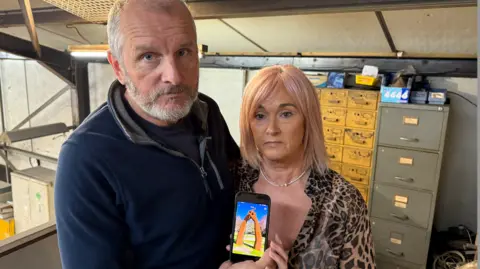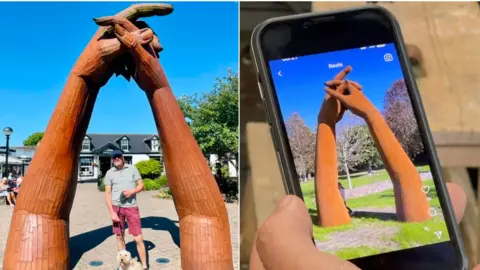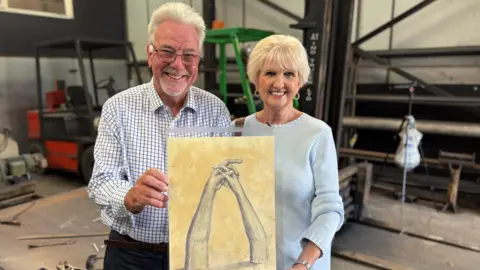Sculptor's legal bid against New Zealand artist
 BBC
BBCA British sculptor who claims his work was stolen by an artist abroad has raised thousands of pounds ahead of a legal challenge to "protect his livelihood".
Ray Lonsdale, from South Hetton, County Durham, believes his 2010 sculpture The Big Dance, in Gretna Green, Scotland, has been replicated by New Zealand sculptor James Wright.
A similar piece of art, featuring two clasped hands with a finger pointing and also made from corten steel, appeared some 3,531 miles away (5,682km) in Clevedon, south-east of Auckland.
Mr Wright, who calls his own artwork Togetherness, told the BBC his artwork was independently researched and there had been "no copyright infringement".
However, Mr Lonsdale, who has created work including Seaham's Tommy and Fiddler's Green in North Shields, North Tyneside, argued his work was copied without any credit, or acknowledgment, to him.
 Ray Lonsdale/BBC
Ray Lonsdale/BBC"You think it's cheeky at first, but then it's a bit beyond cheeky," he told the BBC.
"This piece has only appeared in the last few months, so there's a massive difference timewise and there's no way this one [The Big Dance] is a copy of theirs."
Mr Lonsdale, who runs a business with his son Sam making art from corten steel, which is known for its rusty appearance.
He said any potential copy could undermine his work in creating original sculptures.
"They [the owners of The Big Dance] commissioned a bespoke piece of art and suddenly, it's not... there's another one.
"Imagine putting yourself in that position, you pay a lot of money for art that's unique and somebody copies and claims it as unique, it doesn't sit very well."
'Anything to help'
He is selling limited edition prints of The Big Dance to help meet legal fees, some of which have been spent on a solicitor's letter asking the artist for what he believes should be a credit or acknowledgment of his work.
He said, if this was unsuccessful, he would take the case to a court, which could potentially be heard in the UK or New Zealand.
"[This] is to protect our livelihoods, we've worked for 20-odd years at this," he said, adding: "We're not prepared to take aspects of it without a fight."

More than 60 prints, which cost £85, have already been sold.
Elizabeth Stott travelled with her husband Michael from Newmarket in Suffolk to buy one of the prints because they wanted to do "anything to help".
"I can imagine how I'd feel if I was doing something and somebody had taken that idea and was owning it as their original work," she said.
"If he'd even said based on an idea, but no, to be saying anybody can do this is not right."
Mr Wright denied that his sculpture was copied from Mr Lonsdale's, and was "conceived and executed independently" with its "distinct style".
He admits, while there "may be a visual similarity", this was because both are sculptures showing joined hands.
He argued it was a "globally recognised motif", adding "no single artist holds ownership over such a universal symbol" and it was "not a copy of anyone else's" work.
